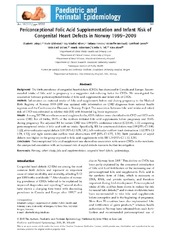| dc.contributor.author | Leirgul, Elisabeth | en_US |
| dc.contributor.author | Gildestad, Trude | en_US |
| dc.contributor.author | Nilsen, Roy Miodini | en_US |
| dc.contributor.author | Fomina, Tatiana | en_US |
| dc.contributor.author | Brodwall, Kristoffer | en_US |
| dc.contributor.author | Greve, Gottfried | en_US |
| dc.contributor.author | Vollset, Stein Emil | en_US |
| dc.contributor.author | Holmstrøm, Henrik | en_US |
| dc.contributor.author | Tell, Grethe Seppola | en_US |
| dc.contributor.author | Øyen, Nina | en_US |
| dc.date.accessioned | 2015-12-21T09:56:56Z | |
| dc.date.available | 2015-12-21T09:56:56Z | |
| dc.date.issued | 2015 | |
| dc.identifier.issn | 1365-3016 | |
| dc.identifier.uri | https://hdl.handle.net/1956/10783 | |
| dc.description.abstract | Background The birth prevalence of congenital heart defects (CHDs) has decreased in Canada and Europe. Recommended intake of folic acid in pregnancy is a suggestive risk-reducing factor for CHDs. We investigated the association between periconceptional intake of folic acid supplements and infant risk of CHDs. Methods Information on maternal intake of folic acid supplements before and during pregnancy in the Medical Birth Registry of Norway 1999–2009 was updated with information on CHD diagnoses from national health registers and the Cardiovascular Diseases in Norway Project. The association between folic acid intake and infant risk of CHD was estimated as relative risk (RR) with binomial log linear regression. Results Among 517 784 non-chromosomal singleton births, 6200 children were identified with CHD and 1153 with severe CHD. For all births, 18.4% of the mothers initiated folic acid supplements before pregnancy and 31.6% during pregnancy. The adjusted RR for severe CHD was 0.99 [95% confidence interval [CI] 0.86, 1.13] comparing periconceptional intake of folic acid with no intake. Specifically, RR for conotruncal defects was 0.99 [95% CI 0.80, 1.22], atrioventricular septal defects 1.19 [95% CI 0.78, 1.81], left ventricular outflow tract obstructions 1.02 [95% CI 0.78, 1.32], and right ventricular outflow tract obstructions 0.97 [95% CI 0.72, 1.29]. Birth prevalence of septal defects was higher in the group exposed to folic acid supplements with RR 1.19 [95% CI 1.10, 1.30]. Conclusions Periconceptional folic acid supplement use showed no association with severe CHDs in the newborn. An unexpected association with an increased risk of septal defects warrants further investigation. | en_US |
| dc.language.iso | eng | eng |
| dc.publisher | Wiley | eng |
| dc.rights | Attribution CC BY | eng |
| dc.rights.uri | http://creativecommons.org/licenses/by/4.0 | eng |
| dc.subject | Norway | eng |
| dc.subject | folic acid supplementation | eng |
| dc.subject | congenital heart defects | eng |
| dc.title | Periconceptional Folic Acid Supplementation and Infant Risk of Congenital Heart Defects in Norway 1999-2009 | en_US |
| dc.type | Peer reviewed | |
| dc.type | Journal article | |
| dc.date.updated | 2015-09-08T10:33:50Z | |
| dc.description.version | publishedVersion | en_US |
| dc.rights.holder | Copyright the authors 2015 | |
| dc.identifier.doi | https://doi.org/10.1111/ppe.12212 | |
| dc.identifier.cristin | 1262571 | |
| dc.source.journal | Paediatric and Perinatal Epidemiology | |
| dc.source.pagenumber | 391-400 | |
| dc.subject.nsi | VDP::Medisinske Fag: 700 | en_US |
| dc.identifier.citation | Paediatric and Perinatal Epidemiology 2015, 29(5):391-400 | |
| dc.source.volume | 29 | |
| dc.source.issue | 5 | |

